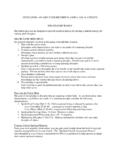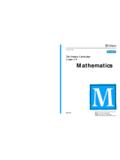Transcription of What is VTS - Castellani Art Museum
1 what is VTS Visual Thinking Strategies (VTS) is a school curriculum and teaching method that Uses art to develop critical thinking, communication and visual literacy skills Asks educators to facilitate learner-centered discussions of visual art Engages learners in a rigorous process of examination and meaning-making through visual art Measurably increases observation skills, evidential reasoning, and speculative abilities Engenders the willingness and ability to find multiple solutions to complex problems Uses facilitated discussion to enable students to practice respectful, democratic, collaborative problem solving skills that over time transfer to other classroom interactions, and beyond Uses eager, thoughtful participation to nurture verbal language skills, and writing assignments to assist transfer from oral to written ability Produces growth in all students, from challenged and non-English language learners to high achievers Underscore connections to art and strengthens the role of museums as a valuable resource in students lives.
2 Abigail Housen and Philip Yenawine developed Visual Thinking Strategies (VTS) in the late 1980 s. Today, VTS is a well-known program used in museums both locally and internationally, as well as in schools, colleges and universities. Philip Yenawine was Director of Education at The Museum of Modern Art from 1983-93, worked as consulting curator at the Institute for Contemporary Art from 1992-94, and was during the academic year 1993-94, Visiting Professor of art education at Mass College of Art, both in Boston. Yenawine is the author of How to Look at Modern Art, Key Art Terms for Beginners, and has written six children s books about art. Yenawine co-founded Visual Understanding in Education (VUE), a non profit educational research organization incorporated in 1996 with a mission to broaden the use of VTS. Abigail Housen, Co-founding Director of VUE and co-author of VTS Curriculum, has been involved in aesthetic research for 30 years.
3 She received her Doctorate of Education from Harvard in 1983. She was professor of Art Education and Director of the Graduate Program at Massachusetts College of Art, and has served as consultant and evaluator to numerous museums and schools. Housen s research into the stages of aesthetic development provided the theoretical foundation for VTS. Her longitudinal research studies on the impact of VTS have shown that, in addition to growth in aesthetic understanding, VTS supports the growth of creative and critical thinking skills, which transfer to other subject areas. (excerpted from ) How Visual Thinking Strategies (VTS) Work VTS is very simple: You, the teacher, act as facilitator and ask students a set of questions while looking at images. After each student s response, you paraphrase what the student said. This lets students know that you understand them and helps ensure that everyone in the group has heard the comments.
4 Repeating what students say also helps them realize that their contributions to discussions are valid. Consequently, students will begin to feel comfortable and confident about speaking up. As you listen to students, point to the parts of the picture they mention, this also demonstrates that you hear them and it keeps the class s attention focused on the image. Asking the questions AND acknowledging each answer by pointing and paraphrasing are the most important things you do in this method. As students become familiar with looking at and talking about art, they will respond to the same questions with increasingly sophisticated observations and interpretations. VTS emphasizes a thinking process based on the viewers knowledge and interests. The strategy does not try to provide any more information than what the viewer observes. The VTS focus on looking and describing constitutes the first step toward building an understanding and appreciation of the visual arts.
5 Questions to Ask during VTS: 1. what s going on in this picture? 2. what do you see that makes you say that? 3. what more can you find? Materials: Actual artworks in the Museum , or Digital images from the collection and an overhead projector (for teachers in the classroom) Process: 1. Show students the image. Always give students a moment to look in silence before you ask them anything and before they are allowed to speak. Stand near the actual artwork, or projected image, and study it along with your students. Do not read the title of the image to your students at this time. Let them make their own discoveries at this stage. (In the Museum , cover the wall label to hide the title.) 2. When ready ask, what s going on in this picture? while pointing to the image. Ask your students to raise their hands so that they do not all speak at once. 3. As each student responds, point to the areas in the picture the student mentions and paraphrase what is said: what I hear you saying or see below.
6 Example: Susan (student): There s a canyon and some houses. You (while pointing): Susan says she sees a canyon and some buildings that look like houses. 4. Confirm that what you paraphrase is what the student means by watching facial expressions and body language. If you are unsure of what a student means, ask the student, Do you 5. If a student makes an interpretive remark ask, what do you see that makes you say that? Example: Paul (student): The house is a happy place. (interpretive remark) You: what do you see that makes you say that? Paul: It reminds me of my grandparents house where I used to spend my summers. I had a lot of fun there. You: Paul sees a house in the picture, which reminds him of a place that holds happy memories. 6. To elicit responses from as many students as possible ask, what more can you find? 7. Let the discussion continue for about fifteen minutes or until your students seem to have run out of things to say.
7 Then let them know that they did a good job looking at the first image and that they will look at another picture. 8. Project another image and again, give your students a few moments to look in silence. When ready, use the same questioning strategy. Begin by asking, what s going on in this picture? Ask, what do you see that makes you say that? to clarify interpretive remarks and finally, what more can you find? to encourage many different responses. Avoid asking other questions, especially those which are leading. Spend approximately fifteen minutes with each image. Teaching Tips: Don t be surprised if you receive a variety of responses that do not seem logical to you. Beginner viewers see things idiosyncratically. Moreover, it is the nature of art to be somewhat open-ended. Students appreciate the fact that different interpretations are possible. Class discussions often develop a consensus about the meaning of a picture, which is usually quite accurate.
8 Silly responses are eventually discarded as students are asked to ground their answers in what they see. Wildly off-base responses also fall by the wayside as students begin to figure out what makes sense. Create a comfortable setting for discussion. The questions are non confrontational, they do not imply that students should know something or demand that they respond in any particular way. You may find this same questioning strategy useful with other art objects and other subject areas. Stick to the three basic questions, avoid asking leading questions. At this stage it is important to let the students make their own discoveries. Practice how you paraphrase your students comments. Paraphrasing helps students feel comfortable and confident about what they have to say, but it is not easy to do. Practice with colleagues or on your own in different situations. Point to the details your students mention, or ask them to do so if you do not see what they see.
9 Let them get up from their seats to do this. Encourage all students to speak and allow them to finish their thoughts completely. You may have to encourage the quieter students. Much of the learning at this stage comes through the process of verbal expression. Speaking enables growth; the silent viewer may not grow commensurate with others. Let all students speak as much as they want to, even if they repeat what others have said, ramble a bit, or miss the point. This will stop after a few lessons. Also, make sure that each student feels that you value his/her contribution to the discussion, regardless of the originality, complexity, or accuracy of the remark. Don t be surprised if there are answers with which you disagree. As long as students explain themselves in terms of what they see, it is better to let a wrong answer stand than to undermine students confidence by speaking out. Resist the temptation to make corrections.
10 Students are learning critical thinking skills in these lessons, not right answers. The method itself often leads to self-correction while students maintain some control of their learning. A summation or review is seldom essential. The experience itself is what is important. Generally, the lack of closure ensures that students will continue to seek out new insights from the images. If you feel that some closure is necessary, ask the students what they might like to remember and share with their families. All questions included are general. They are based on the kinds of questions, concerns, interests, and skills, which emerge in the initial stages of a beginner s viewing history. The questions are designed to allow students to understand that the answers are within him or her. General questions help learners sort out and express what they already know. This questioning strategy is essential for developing sound reasoning, good judgment, and critical and creative thinking.








